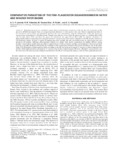Use este identificador para citar ou linkar para este item:
http://www.alice.cnptia.embrapa.br/alice/handle/doc/935114| Título: | Comparative parasitism of the fish plagioscion squamosissimus in native and invaded river basins. |
| Autoria: | LACERDA, A. C. F.  TAKEMOTO, R. M.   TAVARES-DIAS, M.   POULIN, R.   PAVANELLI, G. C.   |
| Afiliação: | A. C. F. LACERDA, UEL R. M. TAKEMOTO, UEL MARCOS TAVARES DIAS, CPAF-AP R. POULIN, University of Otago G. C. PAVANELLI, UEL. |
| Ano de publicação: | 2012 |
| Referência: | The Journal of Parasitology, Lawrence, v. 98, n. 4, p. 713-717, Aug. 2012. |
| Conteúdo: | Biological invasions are considered a major threat to biodiversity around the world, but the role of parasites in this process is still little investigated. Here, we compared parasite infections of a host species in the areas where it originated and where it was introduced, and in native and introduced species in the same environment, using the endoparasites of the fish Plagioscion squamosissimus (Sciaenidae) in 3 Brazilian basins. Samples were taken in 2 rivers where the species is native, i.e., Solimões River (SO) and Tocantins River (TO), and where the species was introduced, the upper Parana´ River (PR). In addition, abundances of diplostomids and larval nematodes were compared between P. squamosissimus and 2 native competitors in the PR, Hoplias malabaricus and Raphiodon vulpinus. In total, 13 species of endoparasites were recorded, but only Austrodiplostomum sp. and cestode cysts were present in all localities. Although infracommunity richness was similar, their species composition was slightly different among localities. General linear models using the relative condition factor of fish as response variables, and abundance of the most prevalent parasites as possible predictors showed that the condition of fish is negatively correlated with parasite abundance only in the native range (TO). Abundance of diplostomid eye flukes was higher in the PR, and in the native species H. malabaricus when compared to the invader, which might present an advantage for P. squamosissimus if they compete for prey. However, although P. squamosissimus may have lost some of its native parasites during its introduction to the PR, it is now possibly acting as a host for native generalist parasites. |
| Thesagro: | Competição biológica Pescada do Piauí |
| Palavras-chave: | Parasito animal |
| Digital Object Identifier: | 10.1645/GE-2882.1 |
| Tipo do material: | Artigo de periódico |
| Acesso: | openAccess |
| Aparece nas coleções: | Artigo em periódico indexado (CPAF-AP)  |
Arquivos associados a este item:
| Arquivo | Descrição | Tamanho | Formato | |
|---|---|---|---|---|
| AP2012Comparativeparasitismofthefishplagioscion.pdf | 186,58 kB | Adobe PDF |  Visualizar/Abrir |









